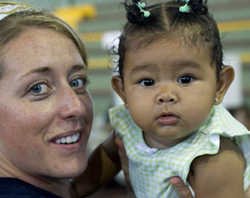
Neonatal Intensive Care in Costa Rica
The Hospital Monseñor Sanabria only has two ventilators in the NICU and can only take care of babies older than 36 weeks.

Earlier this summer, 21 Project HOPE volunteers provided medical care and health education in Costa Rica. Read their stories.
The fat rolls ripple off most of the babies in Costa Rica while their gorgeously big, deep-brown eyes stare at doctors with contentment, curiosity or sometimes confused panic.

Dr. Janet Kinney, a neonatologist and two-time HOPE volunteer, spent time discovering how her own profession is executed in the best medically equipped country in Central America. Kinney visited the local hospital in Puntarenas, where the USNS Comfort is docked, because a new Neonatal Intensive Care Unit (NICU) is under construction.

The 35-year-old Hospital Monseñor Sanabria serves 260,000 people in the region and delivers 3,000 babies a year or about 256 a month, according to Kinney.
The only neonatologist in the hospital is Dr. Rainier Chaves Salino.
Currently the NICU has eight beds, but will make a “great jump” to 13 with the expansion.
“It will take time to grow,” Kinney says.
Since the start of their nursery in 2002, there has been a significant decrease in infant mortality rate for the area of Puntarenas, which is the largest but not poorest province of Costa Rica. While there are good indicators, there is still work to be done.
The Hospital Monseñor Sanabria only has two ventilators in the NICU and can only take care of babies older than 36 weeks because it does not have the capacity to do parental nutrition or TPN, according to Kinney. TPN is used when babies cannot suck, swallow and breath while feeding. So, they get IV fluids pumped into their stomach made up of protein, carbohydrates and minerals.
According to Kinney, all surgical babies are transferred along bumpy roads to San Jose because they do not have the ability to fly patients. In Texas, where Kinney is from, they have a fleet of “fixed-wings” dedicated to babies.
One of the issues in Costa Rican hospitals parallels what Kinney faces all the time in Texas. About 60 percent of the deliveries at Hospital Monseñor Sanabria are by Nicaraguan mothers.
“It really struck me when I learned this, because our nursery is right on the Texas-Mexican border,” said Kinney. A lot of Mexican mothers come to the U.S. because of better medical care and citizenship for their child, which are the same reasons Nicaraguan mothers come to Costa Rica. Costa Rican hospitals also see mothers from Colombia, Haiti and the Dominican Republic.